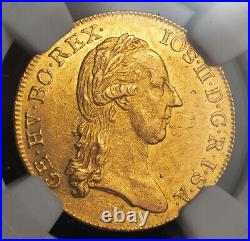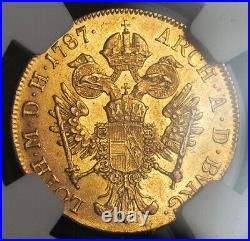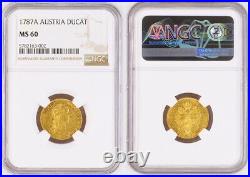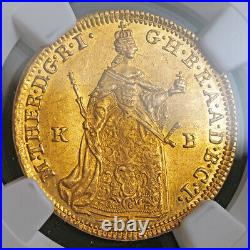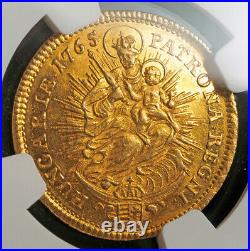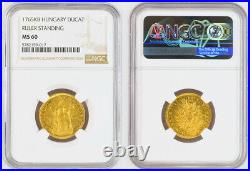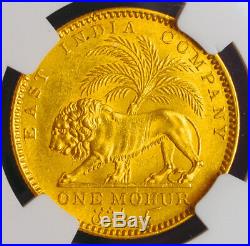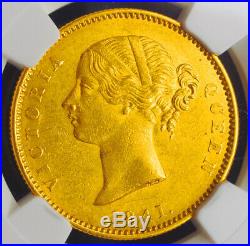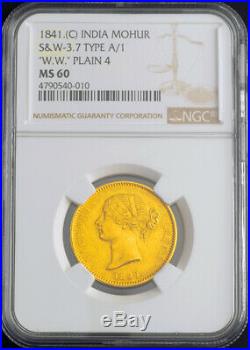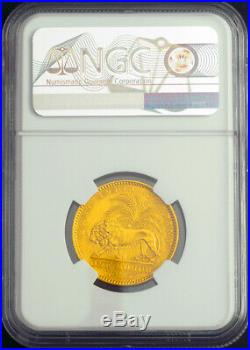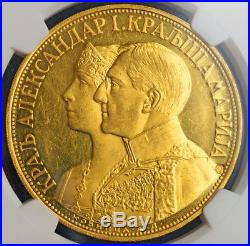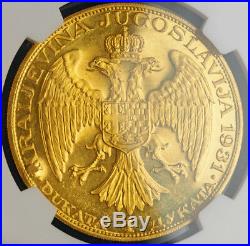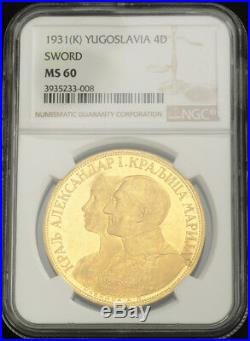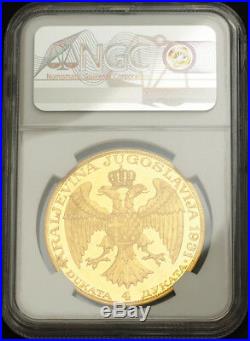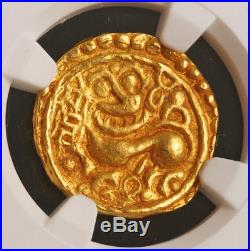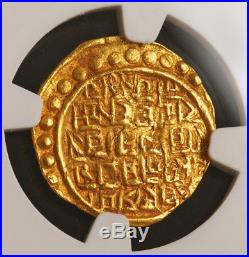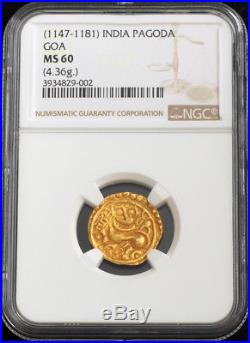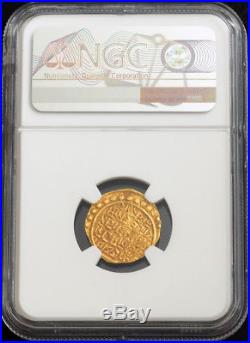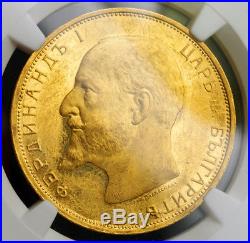
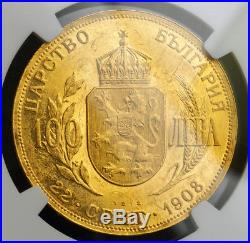
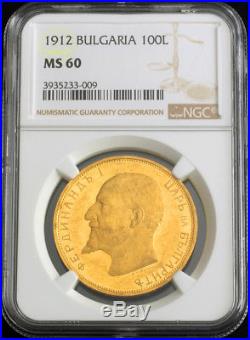
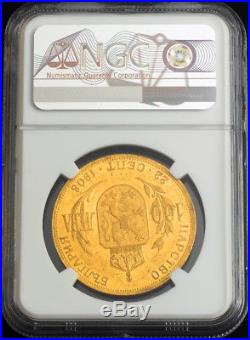

1912, Bulgaria, Ferdinand I. Gold 100 Leva Coin. Mint Place: Vienna Mintage: 5,000 pcs. Marschall Reference: KM-34, Friedberg 5. Certified and graded by NGC as MS-60! This is the original strike with full olive spray details, not the more common 1968 re-strike! Diameter: 35mm Weight: 32.2gm. Obverse: Head of King Ferdinand I left. MARSCHALL below bust´s base. Legend (translated): ” Ferdinand I King of Bulgaria “. Reverse: Crowned shield of the Kingdom of Bulgiaria, splitting denomination (100 – LEVA) on wheat and olive branches. Comment: Date of the issue (1912) in small digits above date of the Bulgaria´s independence (1908) below. Legend (translated): Kingdom of Bulgaria – 22. The lev was introduced as Bulgaria’s currency in 1881 with a value equal to the French franc. The gold standard was suspended between 1899 and 1906 before being suspended again in 1912. Until 1916, Bulgaria’s silver and gold coins were issued to the same specifications as those of the Latin Monetary Union. Banknotes were issued until 1928 were backed by gold. Ferdinand I, Tsar of Bulgaria (February 26, 1861 – September 10, 1948), born. Prince Ferdinand Maximilian Karl Leopold Maria of Saxe-Coburg and Gotha. Was the Knjaz (Prince Regnant) and later Tsar of Bulgaria as well as an author, botanist, entomologist and philatelist. Bulgaria replaced its first Knjaz (Prince), Alexander of Battenberg in 1886, only seven years after he had been installed. Ferdinand was proclaimed Knjaz (Prince Regnant) of autonomous Bulgaria on 7 July 1887 in the Gregorian calendar (the “New Style” used hereinafter). The throne had been previously offered, before Ferdinand’s acceptance, from Denmark to the Caucasus and even to the King of Romania. His accession was greeted with disbelief in many of the royal houses of Europe. Queen Victoria, his father’s first cousin, stated to her Prime Minister, He is totally unfit… Delicate, eccentric and effeminate.. Should be stopped at once. To the amazement of his initial detractors, Ferdinand generally made a success of his reign. Bulgaria’s domestic political life was dominated during the early years of Ferdinand’s reign by liberal party leader Stefan Stambolov, whose foreign policy saw a marked cooling in relations with Russia, formerly seen as Bulgaria’s protector. Ferdinand became Tsar of Bulgaria upon that country’s declaration of independence from the Ottoman Empire on 5 October 1908 (celebrated on 22 September). The Declaration of Independence was proclaimed at the Saint Forty Martyrs Church in Turnovo. It was accepted by Turkey and the other European powers. Ferdinand was known for being quite a character. On a visit to German Emperor Wilhelm II, his second cousin once removed, in 1909, Ferdinand was leaning out of a window of the New Palace in Potsdam when the Emperor came up behind him and slapped him on the bottom. Ferdinand was affronted by the gesture and the Emperor apologised. Another incident particularly occurred on his journey to the funeral of his second cousin, British King Edward VII in 1910. A tussle broke out on where his private railway carriage would be positioned in relation to the heir to the Austro-Hungarian throne, Archduke Franz Ferdinand. The Archduke won out, having his carriage positioned directly behind the engine. Ferdinand’s was placed directly behind. Realising the dining car of the train was behind his own carriage, Ferdinand obtained his revenge on the Archduke by refusing him entry through his own carriage to the dining car. Like many a ruler of an Orthodox land before him, Ferdinand had a “dream of a new Byzantium”. In 1912, Ferdinand joined the other Balkan states in an assault on the Ottoman Empire to free occupied territories. He saw this war as a new crusade declaring it, a just, great and sacred struggle of the Cross against the Crescent. Bulgaria contributed the most and also lost the greatest number of soldiers. The great powers insisted on the creation of an independent Albania. Soon after, Bulgaria attacked its recent allies Serbia and Greece and itself was attacked by Romania and the Ottoman Empire and was defeated. The Treaty of Bucharest in 1913 gave little territorial gains to Bulgaria. A tiny area of land giving access to the Aegean Sea was secured. On 11 October 1915, the Bulgarian army attacked Serbia after signing a treaty with Austria-Hungary and Germany which stated that Bulgaria would gain the territory she sought at the expense of Serbia. See Serbian Campaign (World War I) for details. Ferdinand was not an admirer of German Emperor Wilhelm II (his second cousin once removed) or Emperor of Austria Franz Josef I who he described as “that idiot, that old dotard of a Francis Joseph”. But Ferdinand wanted extra territorial gains after the humiliation of the Balkan Wars. This did however mean forming an alliance with his former enemy, the Ottoman Empire. At first the war went well, Serbia was defeated and Bulgaria took possession of most of the disputed territory of Macedonia. For the next two years, the Bulgarian army fought a defensive war against the Allied army based in Greece. A small part of the Bulgarian army was involved in the conquest of Romania in 1916. Then, in the fall of 1918, the Bulgarian army was badly beaten by an attack from the Allied forces in Greece. With his army shattered, Tsar Ferdinand abdicated to save the Bulgarian throne in favour of his eldest son who became Tsar Boris III on 3 October 1918. Under new leadership, Bulgaria surrendered to the Allies and as a consequence, lost not only the additional territory it had fought for in the major conflict, but also the territory it had won after the Balkan Wars giving access to the Aegean Sea. He had managed to salvage much of his fortune and was able to live in some style. He saw his being in exile simply as one of the hazards of kingship. He commented, Kings in exile are more philosophic under reverses than ordinary individuals; but our philosophy is primarily the result of tradition and breeding, and do not forget that pride is an important item in the making of a monarch. We are disciplined from the day of our birth and taught the avoidance of all outward signs of emotion. The skeleton sits forever with us at the feast. It may mean murder, it may mean abdication, but it serves always to remind us of the unexpected. Therefore we are prepared and nothing comes in the nature of a catastrophe. The main thing in life is to support any condition of bodily or spiritual exile with dignity. If one sups with sorrow, one need not invite the world to see you eat. He was pleased that the throne could pass to his son. Ferdinand was not displeased with exile and spent most of his time devoted to artistic endeavours, gardening, travel and natural history. However, he would live to see the collapse of everything he had held to be precious in life. His eldest son and successor, Boris III, died under mysterious circumstances after returning from a visit to Hitler in Germany in 1943. Boris III’s son, Simeon II, succeeded him only to be deposed in 1946, ending the Bulgarian monarchy. The Kingdom of Bulgaria was succeeded by the People’s Republic of Bulgaria, under which his sole surviving son, Kyril, was executed. On hearing of his son’s death he said, Everything is collapsing around me. He died a broken man in Bürglaß-Schlösschen on September 10, 1948 in Coburg, Germany, cradle of the Saxe-Coburg-Gotha dynasty. Ferdinand I is buried there in St. Augustin’s Roman Catholic Church. The item “1912, Bulgaria, Ferdinand I. Gold 100 Leva Coin. Original Strike! NGC MS-60″ is in sale since Thursday, June 21, 2018. This item is in the category “Coins & Paper Money\Coins\ World\Gold”. The seller is “coinworldtv” and is located in Europe. This item can be shipped worldwide.
- Composition: Gold
- Certification Number: 3935233-009
- Certification: NGC
- Grade: MS60

